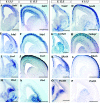Gene expression in cortical interneuron precursors is prescient of their mature function
- PMID: 18250082
- PMCID: PMC2536702
- DOI: 10.1093/cercor/bhm258
Gene expression in cortical interneuron precursors is prescient of their mature function
Abstract
At present little is known about the developmental mechanisms that give rise to inhibitory gamma-aminobutyric acidergic interneurons of the neocortex or the timing of their subtype specification. As such, we performed a gene expression microarray analysis on cortical interneuron precursors isolated through their expression of a Dlx5/6(Cre-IRES-EGFP) transgene. We purified these precursors from the embryonic mouse neocortex at E13.5 and E15.5 by sorting of enhanced green fluorescent protein-expressing cells. We identified novel transcription factors, neuropeptides, and cell surface genes whose expression is highly enriched in embryonic cortical interneuron precursors. Our identification of many of the genes known to be selectively enriched within cortical interneurons validated the efficacy of our approach. Surprisingly, we find that subpopulations of migrating cortical interneurons express genes encoding for proteins characteristic of mature interneuron subtypes as early as E13.5. These results provide support for the idea that many of the genes characteristic of specific cortical interneuron subtypes are evident prior to their functional integration into cortical microcircuitry. They suggest interneurons are already relegated to specific genetic subtypes shortly after they become postmitotic. Moreover, our work has revealed that many of the genes expressed in cortical interneuron precursors have been independently linked to neurological disorders in both mice and humans.
Figures






References
-
- Anderson SA, Eisenstat DD, Shi L, Rubenstein JL. Interneuron migration from basal forebrain to neocortex: dependence on Dlx genes. Science. 1997;278:474–476. - PubMed
-
- Anderson SA, Qiu M, Bulfone A, Eisenstat DD, Meneses J, Pedersen R, Rubenstein JL. Mutations of the homeobox genes Dlx-1 and Dlx-2 disrupt the striatal subventricular zone and differentiation of late born striatal neurons. Neuron. 1997;19:27–37. - PubMed
Publication types
MeSH terms
Substances
Grants and funding
LinkOut - more resources
Full Text Sources
Other Literature Sources
Medical
Molecular Biology Databases
Research Materials

